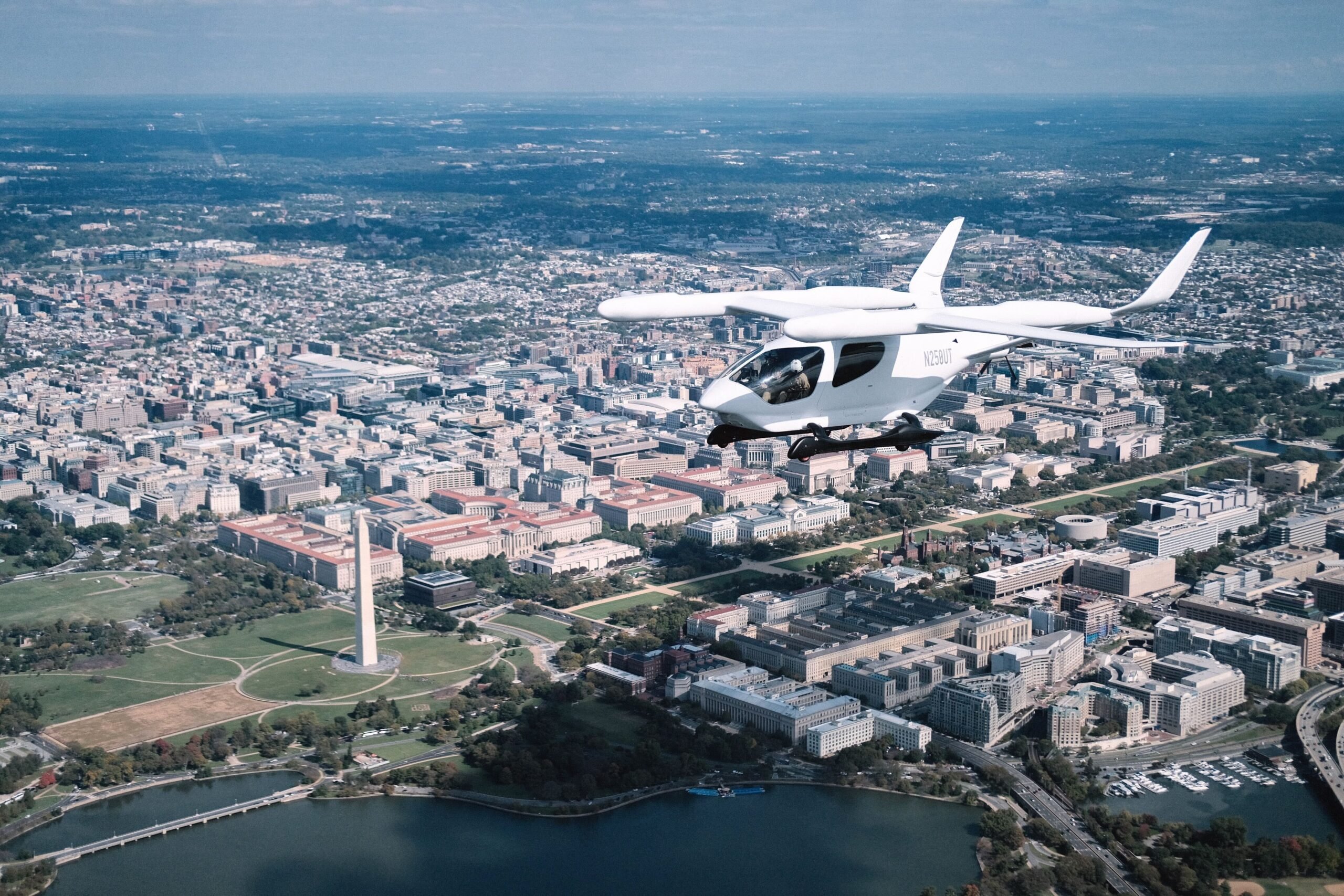
The ALIA aircraft is pictured flying over Washington, DC. (BETA photo)
WASHINGTON — BETA Technologies, a Vermont-based electric aircraft startup, today deployed its ALIA aircraft to Eglin Air Force Base in Florida — in what the company and Air Force are saying is the first manned electric aircraft to be delivered to the service.
The ALIA trudged its way from Vermont down the East Coast, which involved what the company says is the first flight of an electric aircraft in Washington, DC airspace. Now at Duke Field, an auxiliary airfield of Eglin, the aircraft will begin a minimum three-month test campaign, with possible extensions.
“The involvement of the military massively augments our velocity on the commercial side because the military’s expectation of an airplane is fundamentally the same as the FAA’s. They want a safe, reliable, repeatedly produced aircraft,” Kyle Clark, BETA founder and CEO, said in a Wednesday interview with Breaking Defense ahead of the ALIA’s arrival.
The Air Force’s Agility Prime program, which is run through the service’s innovation arm known as AFWERX, has been helping cultivate new aircraft like the ALIA to seize upon a burgeoning electric-powered aircraft market. Earlier this month, Joby Aviation, a separate electric vertical takeoff and landing (eVTOL) startup, delivered its own aircraft to the Air Force as part of the Agility Prime effort. (The Joby aircraft for the time being is remotely operated, though the Air Force plans to bring pilots on board next year.)
“Generally speaking… after there’s a product [and] requirements, we’re testing to make sure that that product meets those requirements,” Air Force Maj. Riley Livermore, flight test commander with the 413th Flight Test Squadron at Duke airfield, said in a Wednesday interview.
“Here, we’re able to kind of jump in with the companies and potential end users much farther left of that, and start to kind of explore the realm of the possible, like, what could we do with this technology?” he added.
Going forward, the Air Force plans to test the ALIA in partnership with BETA at Duke. Air Force pilots have flown the ALIA before, though the “deployment” arrangement will be slightly different, Livermore explained. BETA will own and operate the ALIA at Duke and Air Force pilots won’t fly it, though Livermore left the door open to that opportunity down the road.
The all-electric ALIA has flown 336 nautical miles in a single charge, has a carrying capacity of 1,250 lbs and its cruise speed is around 100 knots, according to a company spokesperson. The ALIA can seat six people including the pilot and could be used for other missions like cargo transport. It can also serve as either an eVTOL or conventional aircraft depending on its configuration, according to Clark. (Livermore said the Air Force would initially work with the eCTOL version.)
The aircraft’s arrival will afford the Air Force the opportunity to learn how to work with new electric technologies, Livermore said, as interest in the sector grows to cut down carbon emissions. For example, the Air Force’s ground campaign can test battery storage procedures, how tugs can tow the aircraft and what maintenance procedures are best.
“The thing we’re excited about with BETA specifically is the fact that it’s manned,” Livermore said. He further noted that the Air Force has developed three flight mission profiles that “are kind of genericized missions,” which mirror military or commercial use cases.
“For me, it’s just been a great opportunity to get a lot smarter on batteries. Like even the charging station just like surprised me honestly, like how hard it was to put a high-voltage charging station in,” he said. As part of the aircraft’s deployment, BETA also commissioned a charger developed by the company — the military’s first for electric aircraft — at Duke and is developing a nationwide network of charging stations that are compatible with multiple aircraft.
Clark said BETA is moving toward production of the ALIA, and that partnering with DoD has afforded “multiple ways to win” through commercial and military applications, which in turn has lured greater capital investment.
“I think the Air Force will learn something that I’ve observed by working with other military programs and electrification in the past: that the hidden gem of electrification is a gross reduction in maintenance and a gross increase in uptime,” said Clark.
One smaller lesson might be “in situ” recharging, according to Clark. Rather than swap a depleted battery out with one that’s fully charged, it probably makes more sense just to recharge the one that’s already in.
“Give it 15 to 30 minutes and go do your thing,” he said. Users will realize that “by the time I got out of the airplane, debrief the flight and loaded a backup, it’s recharged,” he continued. “Why would I ever take the batteries out?”








